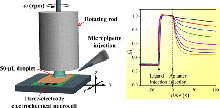Publication
731
J. Am. Chem. Soc., 135 (38), 14215-14228, 2013
DOI: 10.1021/ja405415q
|
|
|
|
|
|
 |
Kinetic Rotating Droplet Electrochemistry: A Simple and Versatile Method for Reaction Progress Kinetic Analysis in Microliter Volumes |
|
|
|
Lylian Challier, Rebeca Miranda-Castro, Damien Marchal, Vincent Noël, Francois Mavré, and Benoit Limoges
ITODYS, UMR 7086 CNRS, and ‡Laboratoire d’Electrochimie Moléculaire, UMR 7591 CNRS, Université Paris Diderot, Sorbonne Paris Cité, 15 rue Jean-Antoine de Baïf, F-75205 Paris Cedex 13, France
Here, we demonstrate a new generic, affordable, simple, versatile, sensitive, and easy-to-implement electrochemical kinetic method for monitoring, in real time, the progress of a chemical or biological reaction in a microdrop of a few tens of microliters, with a kinetic time resolution of ca. 1 s. The methodology is based on a fast injection and mixing of a reactant solution (1–10 µL) in a reaction droplet (15–50 µL) rapidly rotated over the surface of a nonmoving working electrode and on the recording of the ensuing transient faradaic current associated with the transformation of one of the components. Rapid rotation of the droplet was ensured mechanically by a rotating rod brought in contact atop the droplet. This simple setup makes it possible to mix reactants efficiently and rotate the droplet at a high spin rate, hence generating a well-defined hydrodynamic steady-state convection layer at the underlying stationary electrode. The features afforded by this new kinetic method were investigated for three different reaction schemes: (i) the chemical oxidative deprotection of a boronic ester by H2O2, (ii) a biomolecular binding recognition between a small target and an aptamer, and (iii) the inhibition of the redox-mediated catalytic cycle of horseradish peroxidase (HRP) by its substrate H2O2. For the small target/aptamer binding reaction, the kinetic and thermodynamic parameters were recovered from rational analysis of the kinetic plots, whereas for the HRP catalytic/inhibition reaction, the experimental amperometric kinetic plots were reproduced from numerical simulations. From the best fits of simulations to the experimental data, the kinetics rate constants primarily associated with the inactivation/reactivation pathways of the enzyme were retrieved. The ability to perform kinetics in microliter-size samples makes this methodology particularly attractive for reactions involving low-abundance or expensive reagents. |

